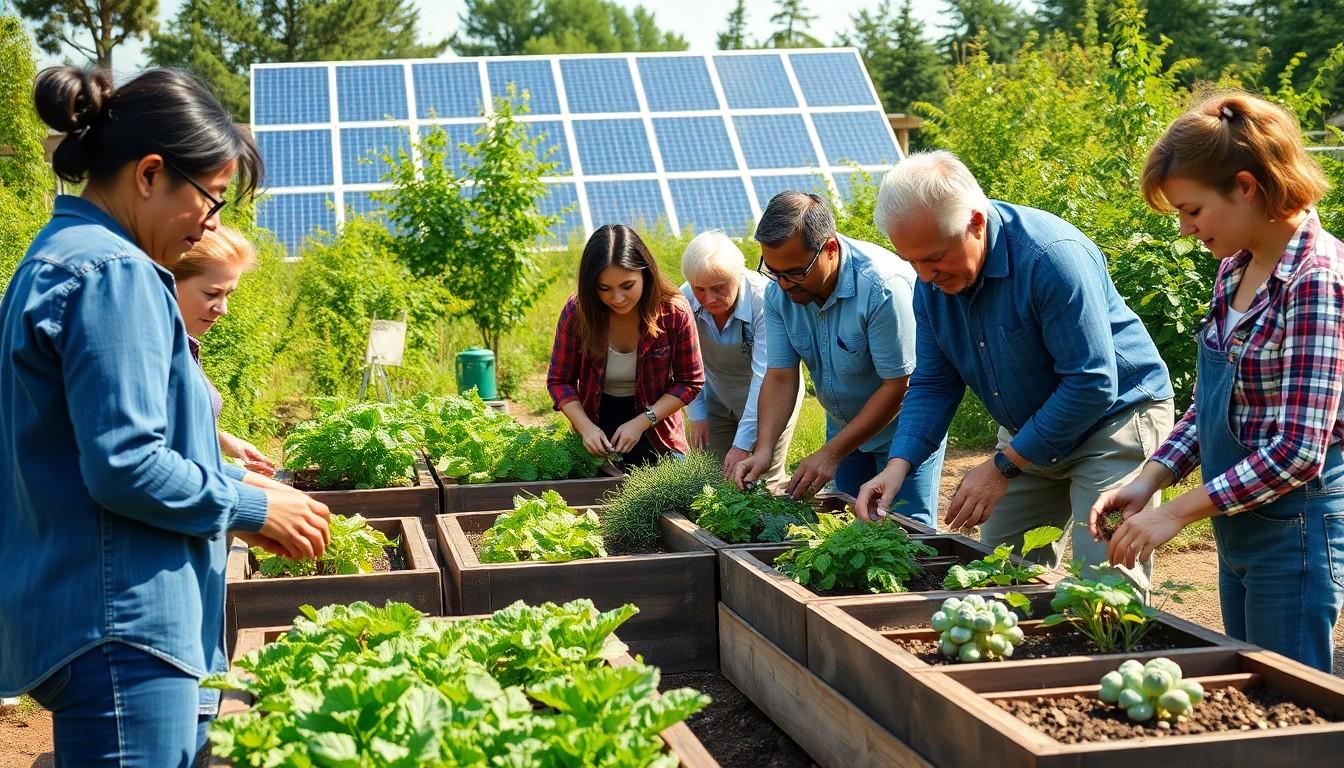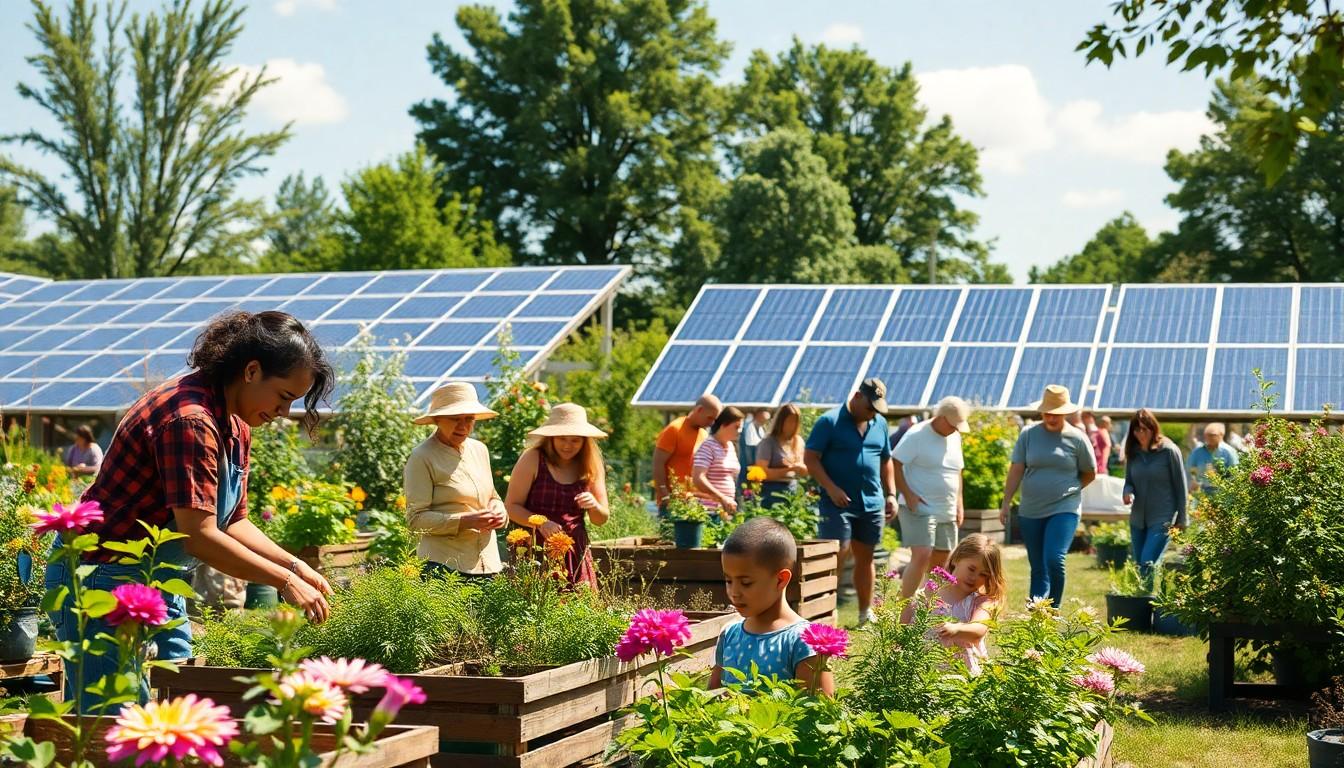Imagine a place where eco-friendly living isn’t just a trend but a way of life. Sustainable living communities are popping up like mushrooms after a rainstorm, and they’re not just for tree-huggers or yoga enthusiasts. These vibrant neighborhoods offer a unique blend of environmental consciousness and community spirit, making them the perfect spot for anyone looking to reduce their carbon footprint while enjoying a little social interaction—because who doesn’t love a good potluck?
Sustainable Living Communities
Sustainable living communities serve as models for eco-friendly lifestyles. These neighborhoods incorporate design principles that maximize energy efficiency and minimize waste. Residents often engage in practices such as composting, rainwater harvesting, and organic gardening.
Communal spaces play a key role in these communities. These shared areas often include gardens, kitchens, and recreational facilities, fostering social interactions among residents. Activities like potlucks and gardening clubs further strengthen community bonds.
Properties within sustainable living communities often feature solar panels and efficient appliances. Such amenities not only lower utility bills but also contribute to a lower carbon footprint. Furthermore, transportation options like bike paths and electric vehicle charging stations support sustainable commuting methods.
Many sustainable living communities offer educational programs. Workshops on topics such as permaculture and renewable energy provide residents with valuable skills. Knowledge sharing enhances community involvement and encourages more sustainable practices.
Diversity in these neighborhoods attracts a range of individuals. Families, singles, and retirees can find shared values rooted in sustainability. An emphasis on collaboration and shared resources creates a supportive environment for all residents.
Economic benefits arise from participating in sustainable living communities. Group purchasing and shared resources can significantly reduce individual costs. Ultimately, these communities combine sustainability with a strong sense of belonging, creating an appealing living option for environmentally conscious individuals.
Key Characteristics of Sustainable Living Communities

Sustainable living communities exhibit distinct traits that contribute to their eco-friendly missions. These characteristics foster a unique environment where residents thrive together.
Eco-Friendly Practices
Sustainable living communities prioritize practices that reduce environmental impact. Composting minimizes waste and enriches the soil. Solar panels provide renewable energy, decreasing reliance on fossil fuels. Residents can also participate in rainwater harvesting, repurposing water for gardens and other needs. Properties frequently utilize energy-efficient appliances, lowering energy consumption. Organic gardening not only supplies fresh produce but also promotes biodiversity. By implementing these methods, communities significantly lower their collective carbon footprint.
Community Engagement
Active participation among residents defines sustainable living communities. Shared communal spaces, such as gardens and kitchens, encourage interaction. Potlucks and events foster stronger relationships and a sense of belonging. Educational programs enhance skills through workshops focused on sustainability topics. Residents collaborate on projects like permaculture and renewable energy initiatives. Diversity among members brings varied perspectives, creating a rich tapestry of ideas and experiences. This engagement nurtures a supportive environment that strengthens community bonds.
Benefits of Living in Sustainable Communities
Living in sustainable communities offers numerous advantages, focusing on environmental benefits and enhancing personal health.
Environmental Impact
Sustainable communities significantly lower ecological footprints through eco-friendly practices. Composting enriches the soil, while solar panels harness renewable energy. Rainwater harvesting captures and repurposes water, reducing reliance on municipal sources. Energy-efficient appliances also decrease electricity consumption. Communities often feature green spaces, promoting biodiversity while improving air quality. Active participation in collective gardening fosters local food production, cutting down carbon emissions associated with transportation. Residents enjoy a lifestyle aligned with sustainability, nurturing a healthier planet for future generations.
Health and Wellbeing
Living in these communities positively influences physical and mental well-being. Access to green spaces encourages outdoor activities which promote fitness. Connecting with nature reduces stress and enhances mood, contributing to overall happiness. Community engagement fosters social connections, combating loneliness and enhancing support networks. Local food production often leads to healthier diets, rich in organic options. Educational programs empower residents to adopt healthier habits, providing valuable knowledge on nutrition and wellness. Strong relationships and a shared commitment to sustainability create a supportive atmosphere, benefiting everyone involved.
Challenges and Considerations
Sustainable living communities face various challenges that require careful consideration. Economic viability poses significant hurdles. Although these communities benefit from collective purchasing, upfront costs for renewable technologies can be high. Long-term savings often compensate for initial investments, yet residents may hesitate without clear financial incentives. Cost-sharing initiatives can enhance accessibility. Inclusive funding strategies, like grants or low-interest loans, improve affordability.
Social dynamics also play a crucial role. Residents may come from diverse backgrounds, creating potential conflicts around values and priorities. Effective communication ensures that everyone’s voice is heard. Establishing shared goals fosters unity and reduces friction. Engagement in social activities helps strengthen relationships, building a sense of belonging. Navigating these dynamics requires ongoing effort. Successful communities prioritize inclusivity and collaboration, ultimately enhancing overall harmony.
Future of Sustainable Living Communities
Future developments of sustainable living communities focus on innovation and resilience. Renewable energy technologies continue evolving, with solar panels becoming more efficient and affordable. Electric vehicle infrastructure expands, supporting cleaner transportation options for residents. Design principles prioritize sustainability, making it simpler for future neighborhoods to adopt eco-friendly practices.
Communal spaces see increased importance as gathering areas for social interaction. Shared gardens and kitchens promote cooperation among residents. Educational programs grow to empower individuals with knowledge around sustainability, enhancing community engagement. Participation in workshops fosters skills in gardening and energy conservation.
Market demand influences the rise of these communities, as more individuals seek eco-conscious living. Developers notice the appeal of sustainable living environments, leading to a growth in available options. Financial incentives, such as tax breaks or grants, encourage investments in sustainable infrastructure.
Social equity also plays a vital role in future sustainable living communities. Efforts focus on inclusivity to welcome diverse backgrounds and perspectives. Integrating affordable housing options addresses economic barriers, ensuring accessibility for all. Residents actively work together, fostering unity to achieve shared sustainability goals.
Health and well-being of individuals improve further with expanded green spaces. Access to parks and outdoor activities offers physical and mental health benefits. Research indicates that community cohesion reduces stress levels, promoting a supportive atmosphere.
Environmental education remains a priority, shaping future generations’ understanding of sustainability. Schools in these communities integrate hands-on learning experiences, cultivating respect for nature. Youth engagement leads to long-term commitment to eco-friendly practices, ensuring a sustainable lifestyle for generations to come.
Eco-Friendly Future
Sustainable living communities represent a promising shift toward a more eco-friendly future. They not only offer a solution to environmental challenges but also foster strong social ties among residents. By prioritizing shared resources and sustainable practices, these neighborhoods create a sense of belonging and community engagement.
As they continue to evolve, the focus on innovation and inclusivity will drive their growth. The integration of renewable technologies and educational initiatives will empower residents to embrace a sustainable lifestyle. Ultimately, these communities are paving the way for healthier living environments and a more sustainable planet for generations to come.

